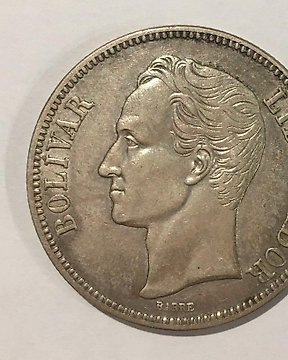
Venezuela. 5 bolivares 1935
N.º 82763387

N.º 82763387

Soberano - Añejo - Brandy Jerezano (3 Bottles)
Gonzalez Byass - (Jerez de la Frontera)
Brandy de Jerez
Jerez-Xerez-Sherry
Year of constitution of the solera: 1896
Bottled 1950s, precinto 80 Céntimos (Tax stamp)
Tapón corcho, Cork stopper
"This great bodega, the largest in Jerez, was established by Manuel Maria Gonzalez Angel in 1835. His father, Don Jose Antonio Gonzalez y Rodrigo was a knight of the royal guard of Carlos III, but despite being popular with the King, he had a reputation with the ladies and was “banished” to Sanlucar with the position of Administrator of the Royal Salt Marshes, a post in which he excelled. He married Maria del Rosario Angel and they had two daughters and five sons.
Manuel Maria, born in Sanlucar in 1812, was a sickly child, and rather than be sent to university in Seville, he was sent to Cadiz for his health, working as a merchant and in a bank. In 1835, a year after his father’s death and aged only 23 he went into the Sherry business. To do this, he borrowed money from one Francisco Gutierrez Aguera to buy a vineyard and was helped by his uncle, Jose de la Peña who owned a small bodega in Sanlucar.
The beginnings were small, exporting only 10 butts in 1835 but growing to 67 in 1836 and 819 in 1837. Things were moving fast and Manuel took on a partner, Juan Bautista Dubosc, a fine salesman from Cataluña who spoke languages, and the firm was renamed Gonzalez Dubosc. Manuel concentrated on Sherry production and Juan on selling it. Meanwhile Manuel married Victorina de Soto y Lavaggi from the aristocratic Soto de Briviesca family. Dubosc died in 1859, but by this time Manuel was also working with Robert Blake Byass, his agent in England.
By 1853 the firm was acquiring more vineyard and began construction of a huge bodega, La Constancia, and the first butts placed there were those ancient wines acquired from the Duke of Medinaceli which would form the solera for Amontillado del Duque. By the time the bodega was finished, exports to England alone stood at 3,000 butts.
Robert Blake Byass had been a very successful agent in England, and in 1863 he was taken into partnership, the firm being renamed Gonzalez Byass. The two families carried on the business until 1988, when the Byass family sold out to the Gonzalez family, giving them full ownership.
One lovely story took place in 1862 on the occasion of a visit by Queen Isabel II. Her wish was to watch the treading of the grapes, but as the visit took place in October, the treading was long over. Undaunted, Manuel sent people out to buy any "uvas de cuelga" or grapes which had been kept for eating and succeeded in obtaining enough (23,000kg!) to put on a show for the Queen. The wine thus produced was of such quality that it was kept in a huge barrel containing the equivalent of 33 butts. As Christ was 33, the barrel was named El Cristo, and was flanked with normal butts of top quality wine which are known as the Apostoles. There were to be many Royal visitors, and each one had a butt (or even solera) laid down in their honour which can still be seen there today.
All the while in the background was Manuel’s uncle Jose. Being from Sanlucar he was naturally a huge fan of the Sanlucar wine, the Manzanilla. He disliked the Jerez wine, and as a favour Manuel kept a few butts of Manzanilla for him when he visited. It was known as “Tio Pepe’s wine” (uncle Joe’s wine), and went on to become the largest-selling Fino in the world.
In the mid XIX century the firm began distilling brandy, and met with great success. They are the only firm which still distils in Jerez (Lepanto). By 1873 GB was the number one exporter, continually acquiring more vineyard and building more bodegas, one of the most interesting of which was “La Concha”, a circular building with a wrought iron roof, often- though inaccurately- attributed to Gustave Eiffel. Manuel Maria died in 1887 at 75 years of age having built up a formidable business, and the firm passed to his son, Pedro Nolasco Gonzalez Soto."
Como comprar na Catawiki
1. Descubra algo especial
2. Faça a licitação vencedora
3. Faça um pagamento seguro